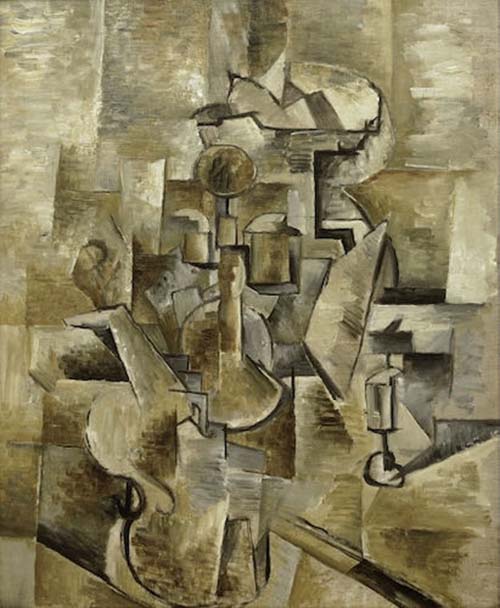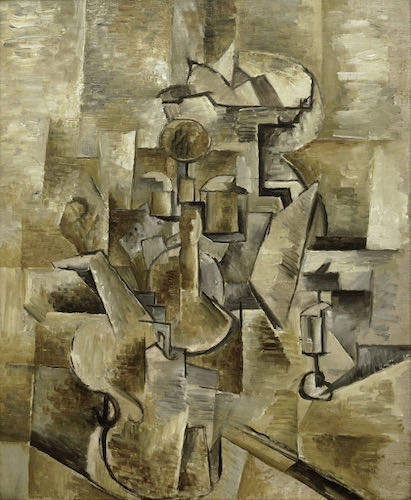
Georges Braque. The Leader of Cubism...
ArtWizard, 12.08.2019
"What attached me in particular and became the main direction in Cubism, was the materialisation of the new space that I sensed. So I began concentrating on the still life, because the still life possesses a tactile space one might almost describe as “manual"… For me, this corresponded to a wish I had always had in touch a thing rather than simply to look at it. This space attached me so much because the quest for space was foremost a Cubist quest. Colour played only a minor role. The only aspect of colour that interested us was light. Light and space are closely related and we dealt with them together."
Georges Braque
Georges Braque is one of the most eminent French artists if the 20th century. He is most well known for being the founder of Cubism alongside Pablo Picasso, although he did other form of works, such as Impressionism, Fauvism, and even some collage styles of work, which brought together a series of imaginative pieces, bold colours, and distinct shapes and styles of art. He was born in a small town near Paris and was at the time inspired by the French Impressionists and Post- Impressionists artists of the Parisian art society.
As a young man, he worked during the day as a house painter and decorator, in the same line of work as his father and grandfather, and he attended evening classes at the School of Fine Arts in Le Havre, France. In 1902, he received his certificate as a decorator, but still attended art school, at the Humbert Academy, where he studied until 1904.
Braque’s early works were impressionistic, but transitioned into a fauvist style after seeing work exhibited by the Fauves in 1905. By 1907, his fauvist works were exhibited at the Salon des Independents. A distinctive feature of his works during that period was not only a unique decorative beauty but also much more vivid than that of other artists, constructiveness of the composition. Unlike other fauvist painters, Braque paid attention not only to the position of the colour elements on the plane of the picture but also to building space.
Even at that time, he was inspired by the compositions of Cézanne more, than by the colours used by Van Gogh. He then discovered Fauvism, and followed the colour and styles of this art movement. He knew at this time Andre Derain and Henri Matisse. Later on, he spent much time working alongside with Picasso, managing to transform Fauvism into Cubism as a new art style. They changed the conventional form of representation of the art objects.
Although Braque began his career painting landscapes, during 1908 he, alongside Picasso, discovered the advantages of painting of natures-mortes.

Georges Braque, Violin and Candlestiks, 1910
Braque explained that he “… began to concentrate on still-lives, because in the still-life you have a tactile, I might almost say a manual space… This answered to the hankering I have always had to touch things and not merely see them… In tactile space you measure the distance separating you from the object, whereas in visual space you measure the distance separating things from each other. This is what led me, long ago, from landscape to still-life”
Besides the cubist paintings, Georges Braque also experimented with collages, and the use of the entire canvas, to convey pieces that were created. In 1922, he had a very successful solo exhibit in Paris, which not only garnered much attention to his work, but also to the new form which he and Picasso had introduced. It not only showcased the new colour and collage style paintings, it also helped propel him to the front of the art world, as a prominent name during this period. It is interesting to know that Braque maintained that Matisse, on the judging panel for the Salon d’Automne in 1908, rejected a selection of Braque landscape paintings influenced by Cézanne. One rumoured reason for Matisse’s decision is a bitterness he harboured because Braque had abandoned him for Picasso. Officially, the works were rejected because they were made of “little cubes”, marking the origins of ‘Cubism’.
Beginning in 1909, Braque began to work closely with Picasso, who had been developing a cubist style of painting. At the time, Picasso was influenced by the Impressionists, African art, especially masks, and Braque was interested mainly in developing Cézanne's ideas of multiple perspectives. Some critics say that “A comparison of the works of Picasso and Braque during 1908 reveals that the effect of his encounter with Picasso was more to accelerate and intensify Braque’s exploration of Cézanne’s ideas, rather than to divert his thinking in any essential way.”
.jpeg)
Georges Braque, Still Life with Banderillas, 1911
Braque did not immediately appreciate Picasso innovative work in cubism, but nonetheless the pair developed a close relationship. Introduced by Apollinaire, the artists explored the philosophies of Abstraction and in 1912 Braque experimented with cardboard and paper sculpture, earning the nickname ‘Wilbur Wright’ from Picasso. Both artists aimed to eliminate any subjective element from their works and even refused to sign them by hand.
Later on, the artist experimented with different styles, but there were always aspects of the cubism style, in every piece he created, regardless of which period he was working in, or which new style he was focused in on.
.jpeg)
Georges Braque, The Portuguese, 1911
Braque used to leave some of his work unfinished for decades, as he left works like ‘Guéridon’ (started 1930 and completed 1952) for years before finishing them. This led to stylistic interruptions in his oeuvre, with some works displaying much earlier techniques interjected among his current production. Braque’s inimitable patience explains this practice, as the artist waited until the works revealed their identity.
Braque was the first living artist to have a solo exhibition at the Louvre.
.jpeg)
Georges Braque, Bottle and Fishes, 1910-12
The artist was commissioned to paint three ceilings in the Etruscan room in the Louvre. The three panels show a large bird, a motif from the latter stages of Braque’s life. Braque thought the motif “universal”, allowing him to paint space while respecting two-dimensional constraints. In 1961, Braque was awarded a solo exhibition in the Louvre, named “L’Atelier de Braque”.
Braque spent the last thirty years of his life in Varengeville (France) and his presence is marked by three stained-glass windows he designed for the chapel. Following a state funeral, Braque was buried in the graveyard at Varengeville alongside artists including Jean-Francis Auburtin and Paul Nelson. The cliff-top churchyard recedes by around a meter a year, despite numerous preventative attempts: like the remains it conceals, the cemetery is falling victim to the elements. A poignant end, perhaps, for an artist with an appreciation of metamorphosis and circumstance. Although the artist did have issues with his health a majority of his life, he managed to create and lead a new art movement. Alongside Picasso, Georges Braque may have been one of the most influential painters of the early 20th century.
